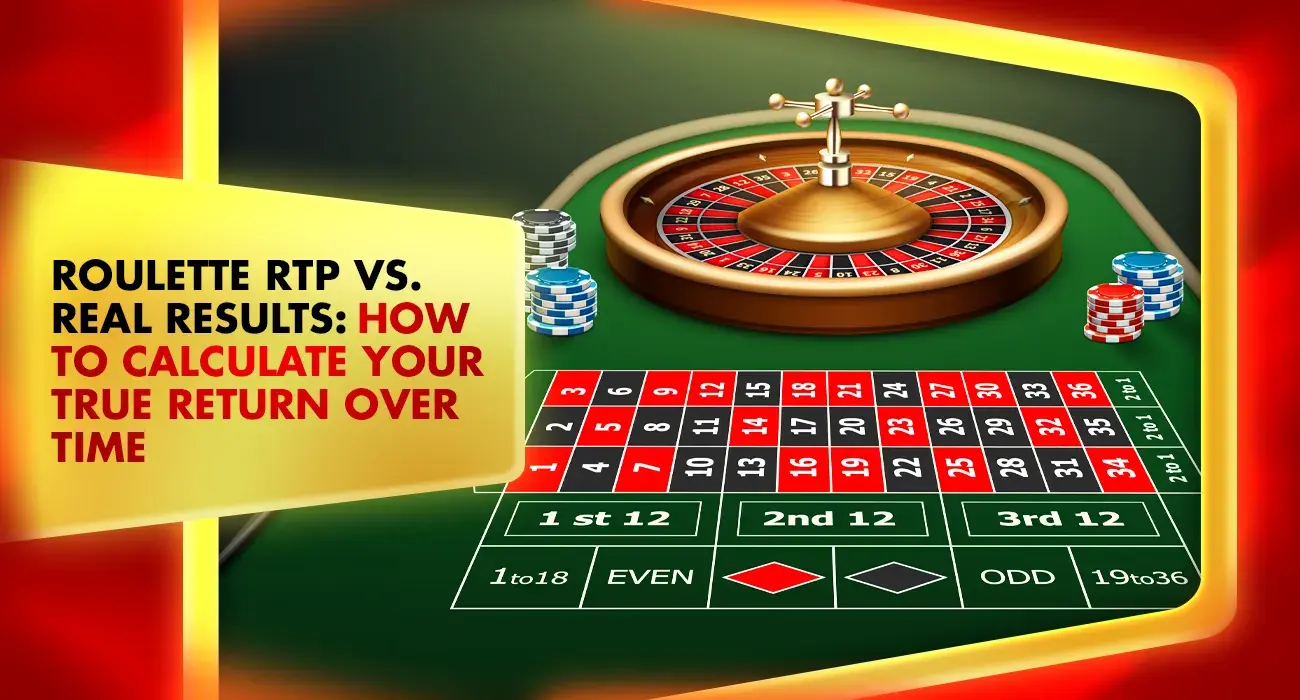Every roulette player eventually encounters the same surprise: the game’s advertised RTP and your own real-world results don’t always match. In fact, the gap between them can feel enormous. You may play a wheel listed at 97.30% RTP and still walk away with a 40% loss, or sometimes a sudden streak leaves you far ahead of expected value.
So what’s going on? Why doesn’t RTP predict what you personally win or lose in each session? And how do smart players calculate their actual return over time, rather than relying on theoretical numbers?
Whether you play on desktop or the Khelraja online casino mobile app, understanding how RTP interacts with variance, session length, bankroll size, and bet type is the key to becoming a more strategic and data-driven roulette player.
Let’s break down the truth behind RTP — and how to compute your true return like the pros.
What RTP Really Means (And What It Doesn’t)
RTP — or Return to Player — is a long-term mathematical average. In roulette, it’s based on millions of simulated spins. For European wheels (single zero), the commonly quoted RTP is 97.30%. For American double-zero wheels, it drops to 94.74%.
But RTP does not mean:
- You get back 97.30% of your money every session
- You will always finish close to break-even
- Results normalize after a few dozen spins
Instead, RTP only reflects how the game behaves over extremely large sample sizes — far larger than what any individual player experiences. Your real return depends on:
- Bet selection
- Volatility
- Hit frequency
- Bankroll size
- Session length
- Emotional discipline
- Timing and decision-making
This is why players who rely on RTP alone often misunderstand what their long-term expectation actually is.
Understanding Real Results: The Impact of Variance
Before you calculate your true return, you must understand variance — the natural deviation from the expected outcome.
Roulette has high short-term variance because:
- Each spin is independent
- Inside bets have low hit rates but high payouts
- Outside bets hit often but pay less
- Streaks appear randomly
- Clusters and droughts are mathematically normal
Your experience in real money earning games sessions comes from variance, not RTP. A few lucky spins can push your results far above expected return, while cold streaks can push you far below it.
This explains why two players at the same table may walk away with completely opposite results.
How to Calculate Your True Return (Actual RTP)
Here’s the formula smart roulette players use:
Actual Return Percentage (ARP) = (Total Winnings ÷ Total Wagered) × 100
This number reveals what RTP you personally experienced — not what the game promises.
Let’s look at an example:
- Total wagered: ₹50,000
- Total winnings returned: ₹41,000
Your Actual Return Percentage = (41,000 ÷ 50,000) × 100 = 82%
This means your personal RTP for that session was 82%, not 97.30%.
But here’s the important part: One session’s ARP is meaningless on its own. You need many sessions logged to see how close your real return trends toward the long-term theoretical number.
Players who track their ARP on a spreadsheet or live casino app note that it often changes dramatically in early games, then slowly stabilizes over time.
Why Your Real RTP Can Be Higher or Lower Than the Game RTP
Before we list examples, here’s the key insight:
Your game type, bet selection, volatility profile, and session discipline all affect your actual return more than the wheel math does.
Reasons Your Real RTP Can Be Lower
- Playing high-variance inside bets
- Short sessions where variance is strongest
- Tilt-driven bet increases
- Switching bet patterns too often
- Not tracking bankroll or session limits
- Losing streaks amplified by emotional betting
Reasons Your Real RTP Can Be Higher
- Several big inside hits in a short span
- High multipliers from special roulette variants
- Sticking to low-variance outside bets
- Playing longer sessions where variance levels out
- Using consistent staking instead of chasing
- Tracking bet density and correcting errors
This is why RTP is not a measure of your skill — but your real results are influenced by your decision-making.
The Role of Bet Type in Your True Return
Your bet choices change your personal volatility and therefore your ARP. Here’s how variance shifts between the major categories:
Outside Bets (Low Volatility)
- Even Chances (Red/Black, Odd/Even, High/Low)
- Dozens / Columns
These bets hit roughly 33% to 48% of the time. Your real return from these bets will typically move closer to the official wheel RTP sooner because of frequent wins.
Inside Bets (High Volatility)
- Straight Up
- Split
- Street
- Corner
- Line
These bets may take hundreds of spins to normalize. One big hit can distort your ARP upward by 20% or more. A long dry streak can distort it downward just as sharply.
Sector Bets
These bets create moderate volatility and produce distinctive trends in ARP evolution.
In short: Your real RTP reflects your volatility choices — not casino math.
Why Session Length Is the Most Important Factor in Real RTP
Most roulette players on the Khelraja online casino platform play short sessions: 10–40 minutes. But RTP is a long-term metric, which means these sessions produce wildly inconsistent results.
- Short sessions = High variance, extreme ARP values
- Longer sessions = Stable variance, ARP moves toward theoretical RTP
If your goal is consistency, longer sessions with controlled staking offer more predictable RTP alignment.
If your goal is hitting big multipliers or lucky inside runs, short sessions with aggressive volatility will massively swing your personal ARP.
How to Track Your True RTP Like a Pro
Before listing the steps, here’s why tracking matters:
You cannot analyze your improvement, discipline, or risk weighting without data. Keeping records transforms roulette from emotional guessing into informed decision-making.
5 Essential Steps to Track Your Real RTP
- Log bankroll start and end for every session.
- Record total wagered, not just profit/loss.
- Calculate ARP using the simple formula.
- Tag sessions by volatility (inside-heavy or outside-heavy).
- Review weekly or monthly trends.
This reveals whether you’re improving — or repeating mistakes.
RTP vs. Real Results: What Smart Players Actually Use
Experienced players don’t rely on RTP for playable strategy. Instead, they:
- Track ARP per session
- Track average bet distribution
- Manage volatility by adjusting bet types
- Stick to a predetermined staking model
- Avoid emotional bet increases
- Use session limits to protect bankroll
- Analyze long-term patterns rather than lucky streaks
Roulette becomes far more sustainable when you measure real results instead of chasing theoretical expectations.
Final Thoughts: Your Real RTP Is the Only Number That Matters
Here’s the truth every roulette player eventually learns:
The only RTP that affects you… is the one you actually experience.
Game RTP is useful as a mathematical baseline, but your personal ARP reveals:
- Your discipline
- Your volatility profile
- Your decision quality
- Your risk exposure
- Your level of growth as a roulette player
If you want to take your roulette performance to the next level at Khelraja online casino, tracking your actual return is the most important step you can take.






